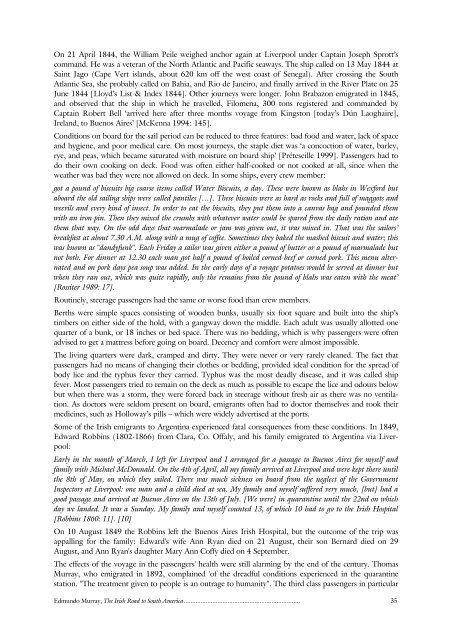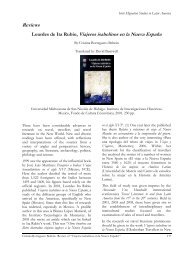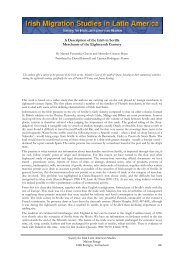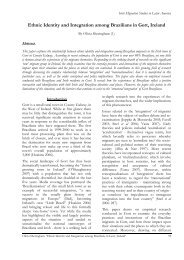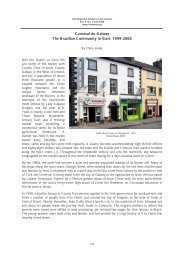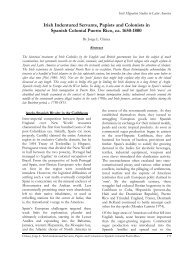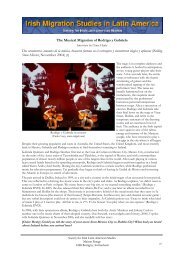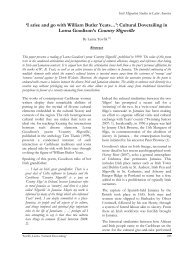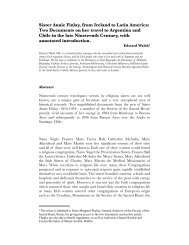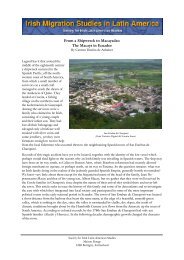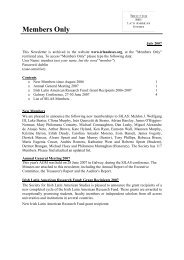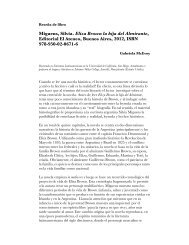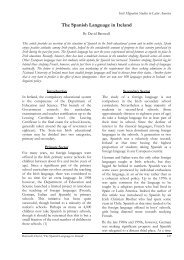I:6 Anti-dumping - Society for Irish Latin American Studies
I:6 Anti-dumping - Society for Irish Latin American Studies
I:6 Anti-dumping - Society for Irish Latin American Studies
You also want an ePaper? Increase the reach of your titles
YUMPU automatically turns print PDFs into web optimized ePapers that Google loves.
On 21 April 1844, the William Peile weighed anchor again at Liverpool under Captain Joseph Sprott’s<br />
command. He was a veteran of the North Atlantic and Pacific seaways. The ship called on 13 May 1844 at<br />
Saint Jago (Cape Vert islands, about 620 km off the west coast of Senegal). After crossing the South<br />
Atlantic Sea, she probably called on Bahia, and Rio de Janeiro, and finally arrived in the River Plate on 25<br />
June 1844 [Lloyd’s List & Index 1844]. Other journeys were longer. John Brabazon emigrated in 1845,<br />
and observed that the ship in which he travelled, Filomena, 300 tons registered and commanded by<br />
Captain Robert Bell ‘arrived here after three months voyage from Kingston [today’s Dún Laoghaire],<br />
Ireland, to Buenos Aires’ [McKenna 1994: 145].<br />
Conditions on board <strong>for</strong> the sail period can be reduced to three features: bad food and water, lack of space<br />
and hygiene, and poor medical care. On most journeys, the staple diet was ‘a concoction of water, barley,<br />
rye, and peas, which became saturated with moisture on board ship’ [Préteseille 1999]. Passengers had to<br />
do their own cooking on deck. Food was often either half-cooked or not cooked at all, since when the<br />
weather was bad they were not allowed on deck. In some ships, every crew member:<br />
got a pound of biscuits big coarse items called Water Biscuits, a day. These were known as blahs in Wex<strong>for</strong>d but<br />
aboard the old sailing ships were called pantiles […]. These biscuits were as hard as rocks and full of maggots and<br />
weevils and every kind of insect. In order to eat the biscuits, they put them into a canvas bag and pounded them<br />
with an iron pin. Then they mixed the crumbs with whatever water could be spared from the daily ration and ate<br />
them that way. On the odd days that marmalade or jam was given out, it was mixed in. That was the sailors’<br />
breakfast at about 7.30 A.M. along with a mug of coffee. Sometimes they baked the mashed biscuit and water; this<br />
was known as "dandyfunk". Each Friday a sailor was given either a pound of butter or a pound of marmalade but<br />
not both. For dinner at 12.30 each man got half a pound of boiled corned beef or corned pork. This menu alternated<br />
and on pork days pea soup was added. In the early days of a voyage potatoes would be served at dinner but<br />
when they ran out, which was quite rapidly, only the remains from the pound of blahs was eaten with the meat’<br />
[Rossiter 1989: 17].<br />
Routinely, steerage passengers had the same or worse food than crew members.<br />
Berths were simple spaces consisting of wooden bunks, usually six foot square and built into the ship’s<br />
timbers on either side of the hold, with a gangway down the middle. Each adult was usually allotted one<br />
quarter of a bunk, or 18 inches or bed space. There was no bedding, which is why passengers were often<br />
advised to get a mattress be<strong>for</strong>e going on board. Decency and com<strong>for</strong>t were almost impossible.<br />
The living quarters were dark, cramped and dirty. They were never or very rarely cleaned. The fact that<br />
passengers had no means of changing their clothes or bedding, provided ideal condition <strong>for</strong> the spread of<br />
body lice and the typhus fever they carried. Typhus was the most deadly disease, and it was called ship<br />
fever. Most passengers tried to remain on the deck as much as possible to escape the lice and odours below<br />
but when there was a storm, they were <strong>for</strong>ced back in steerage without fresh air as there was no ventilation.<br />
As doctors were seldom present on board, emigrants often had to doctor themselves and took their<br />
medicines, such as Holloway’s pills – which were widely advertised at the ports.<br />
Some of the <strong>Irish</strong> emigrants to Argentina experienced fatal consequences from these conditions. In 1849,<br />
Edward Robbins (1802-1866) from Clara, Co. Offaly, and his family emigrated to Argentina via Liverpool:<br />
Early in the month of March, I left <strong>for</strong> Liverpool and I arranged <strong>for</strong> a passage to Buenos Aires <strong>for</strong> myself and<br />
family with Michael McDonnald. On the 4th of April, all my family arrived at Liverpool and were kept there until<br />
the 8th of May, on which they sailed. There was much sickness on board from the neglect of the Government<br />
Inspectors at Liverpool: one man and a child died at sea. My family and myself suffered very much, [but] had a<br />
good passage and arrived at Buenos Aires on the 13th of July. [We were] in quarantine until the 22nd on which<br />
day we landed. It was a Sunday. My family and myself counted 13, of which 10 had to go to the <strong>Irish</strong> Hospital<br />
[Robbins 1860: 11]. [10]<br />
On 10 August 1849 the Robbins left the Buenos Aires <strong>Irish</strong> Hospital, but the outcome of the trip was<br />
appalling <strong>for</strong> the family: Edward's wife Ann Ryan died on 21 August, their son Bernard died on 29<br />
August, and Ann Ryan's daughter Mary Ann Coffy died on 4 September.<br />
The effects of the voyage in the passengers' health were still alarming by the end of the century. Thomas<br />
Murray, who emigrated in 1892, complained 'of the dreadful conditions experienced in the quarantine<br />
station. "The treatment given to people is an outrage to humanity". The third class passengers in particular<br />
Edmundo Murray, The <strong>Irish</strong> Road to South America..................................................................... 35


